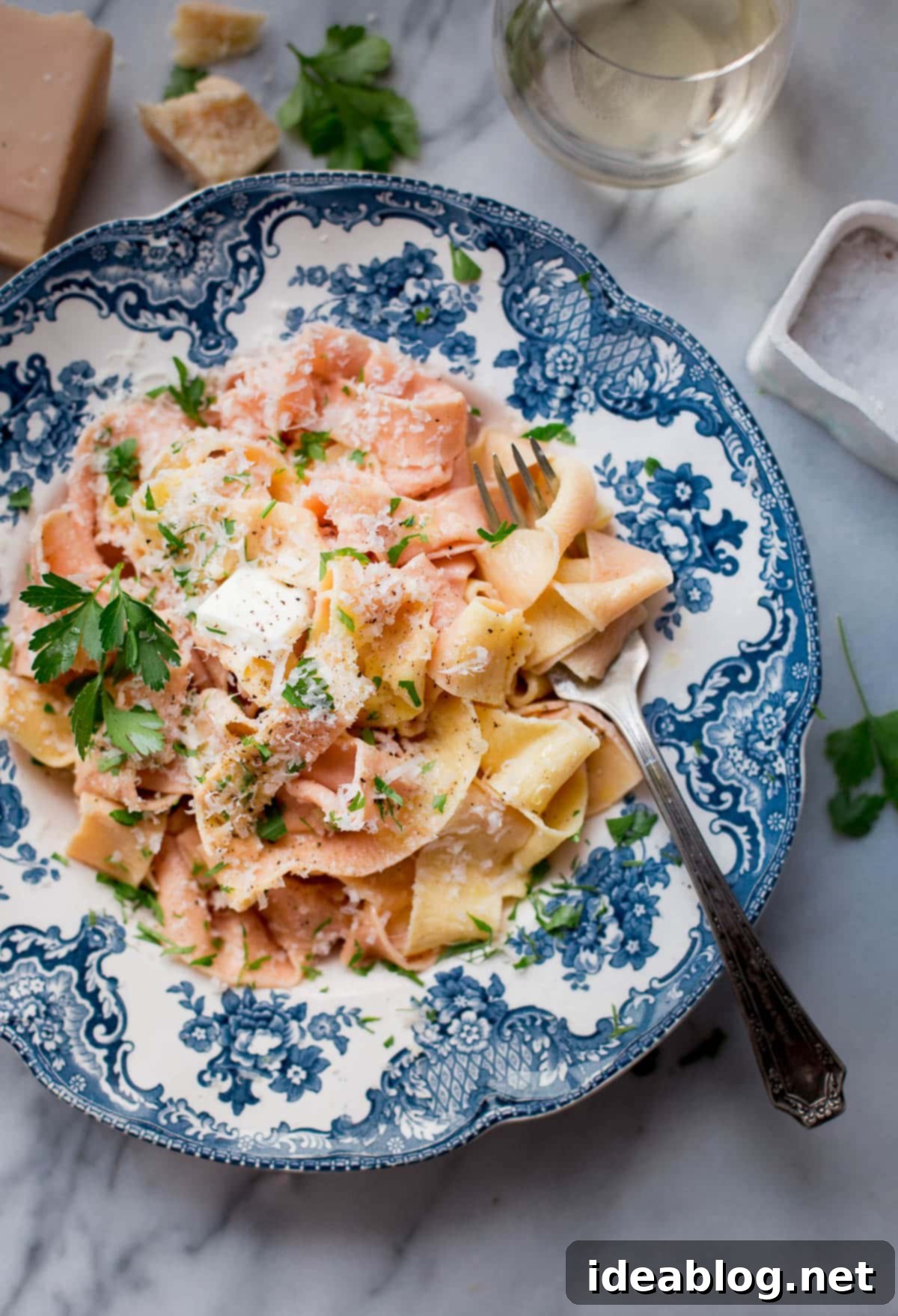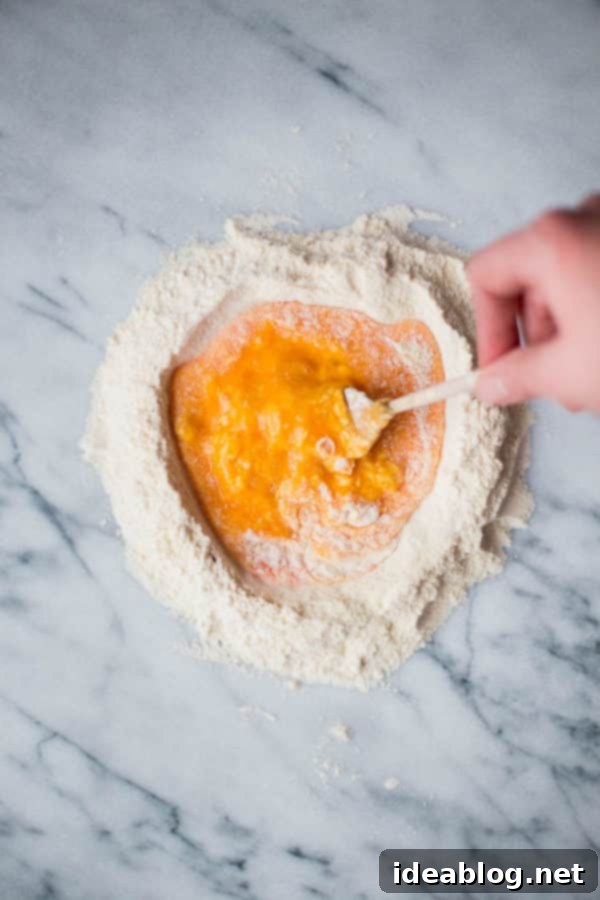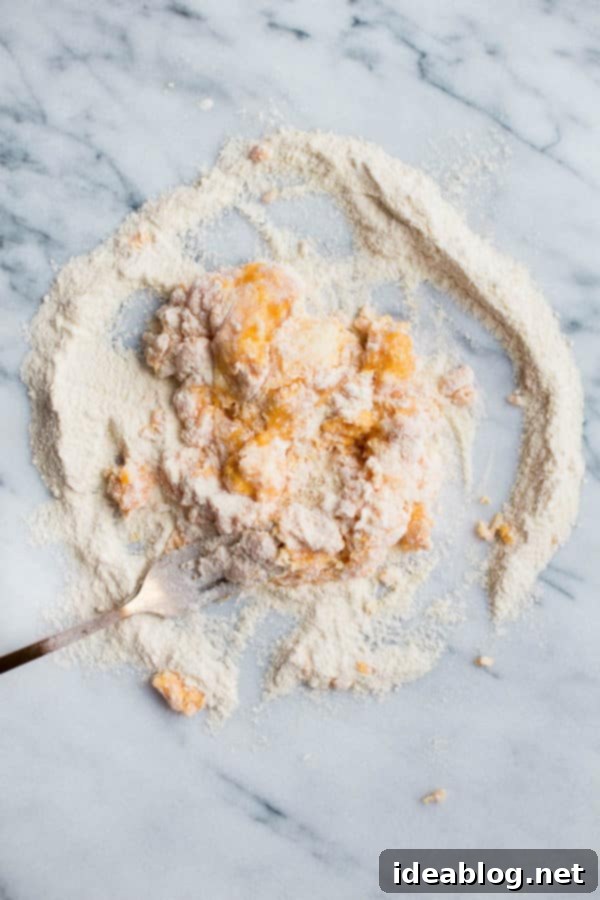Mastering Homemade Pappardelle Pasta: Traditional Egg Noodles & Naturally Pink Beet Pasta Recipe
Embark on a culinary adventure and learn how to craft exquisite homemade pappardelle pasta right in your kitchen. This timeless, traditional egg pasta dough is beautifully simple, made with a perfect blend of all-purpose flour, semolina, and fresh eggs. Choose to make a classic golden version, or add a vibrant twist by naturally coloring the dough a delightful pink with wholesome beet puree. This detailed guide will walk you through every step, ensuring a truly rewarding pasta-making experience.
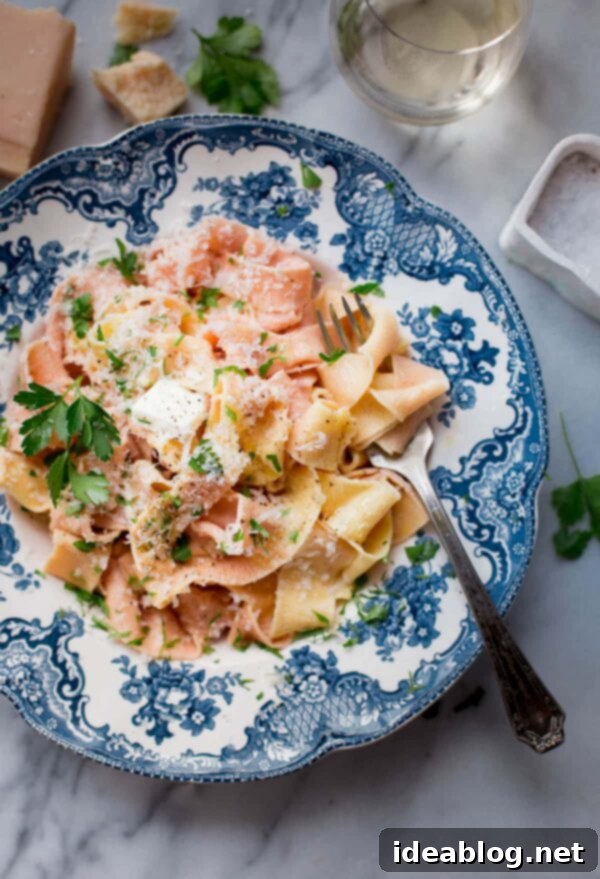
For many, pasta isn’t just food; it’s a love language. It evokes comfort, celebration, and the simple joy of sharing a delicious meal. My own journey with pasta began seemingly at birth, an unconditional love affair that has only deepened over the years. There’s something undeniably magical about a plate of freshly made pasta, and this homemade pappardelle truly encapsulates that feeling.
This recipe offers not just a dish, but an experience. Imagine a mound of tender, wide ribbons of pasta, so luscious and inviting. And for those seeking an extra touch of whimsy and elegance, there’s the option to make it pink – a charming, pastel hue achieved naturally with beet puree. This was my personal nod to celebrating special occasions, a fantastic excuse to dust off the pasta machine and transform simple ingredients into culinary art. What better way to mark a special moment than with a generous bowl of homemade pasta? It’s truly one of life’s greatest, most comforting pleasures, and I say that with every fiber of my pasta-loving being.
A few years ago, I shared a recipe for homemade red pasta, and while beloved, it was ready for an update. This new pappardelle dough builds on that foundation, offering several enhancements. We’re working with a refined base recipe, incorporating beet puree for that beautiful natural tint (a delightful habit, as you might gather from my beet problem!), and most excitingly, we’ll be cutting these wide, rustic pappardelle strands by hand. Homemade egg pappardelle holds a special place in my heart, especially during the colder months and for celebratory meals. Its broad, flat surface is perfect for cradling rich, hearty sauces, whether they are cream-based or robust meat ragus.
Let’s dive into the delightful process of making your own pappardelle. Even if you’re short on time and prefer to use store-bought dry pasta, you can still enjoy a fantastic meal with this creamy leek and pancetta pappardelle recipe, scaled down perfectly for two.
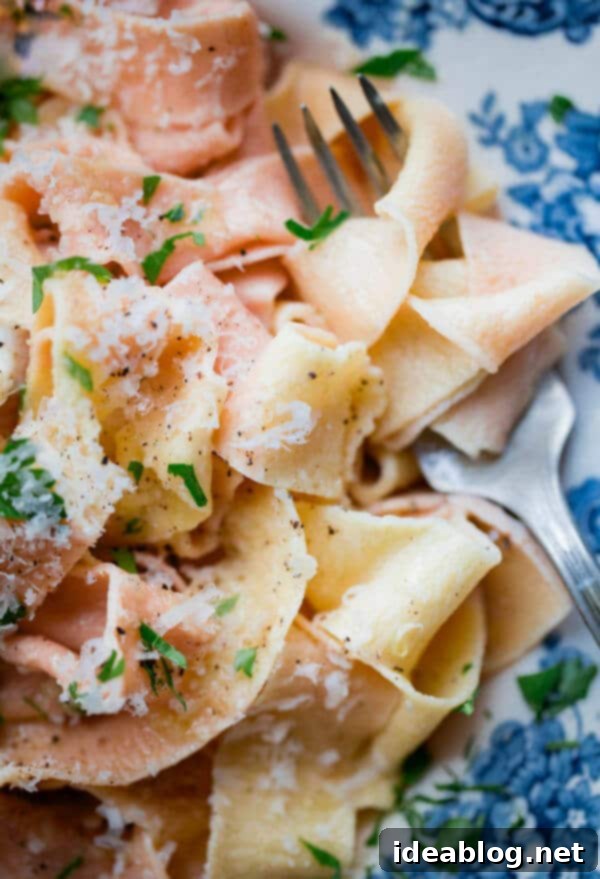
Essential Tools for Crafting Homemade Pappardelle Pasta
If you’re new to the world of homemade pasta, prepare to feel like an Italian culinary superhero once you’ve conquered this recipe. It’s incredibly rewarding! While it’s true that this pasta can be made entirely without a dedicated pasta machine or roller, doing so requires a sturdy rolling pin, a dash of extra enthusiasm, and a fair amount of arm strength. But rest assured, it is absolutely achievable!
However, for optimal ease and consistency, I highly recommend using a pasta machine. If you’re a pasta enthusiast and already own a KitchenAid stand mixer, investing in this attachment set is a game-changer. It frees up both your hands, making the entire process of rolling pasta sheets significantly less time-consuming and much more enjoyable. The machine does the heavy lifting, allowing you to focus on the artistry of pasta making.
Through years of making homemade pasta – both for personal enjoyment, during my time in culinary school, and in professional restaurant settings – I’ve discovered a strong preference for pasta doughs made with a balanced combination of all-purpose flour and semolina flour. My ideal ratio is typically 50/50, as this blend yields a pasta with superb texture and resilience.
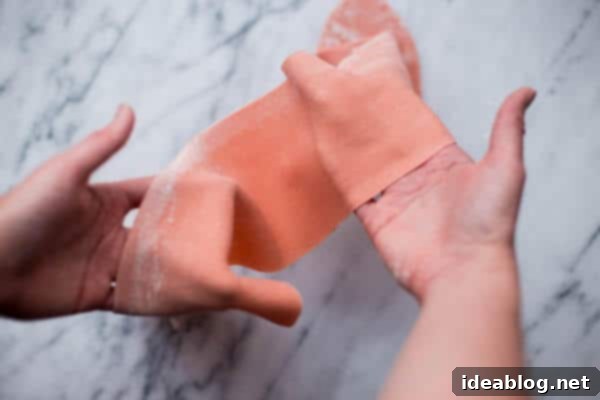
Understanding Semolina Flour: The Secret to Perfect Pasta Texture
Semolina flour, derived from durum wheat, is a crucial ingredient in achieving the desired texture for many Italian pastas. It’s a coarser grain, specifically milled from the endosperm of wheat kernels, and is characterized by its light golden hue. What truly sets semolina apart is its notably higher gluten and protein content compared to other standard flours. If you’re having trouble sourcing it locally, my trusted partner Bob’s Red Mill offers a fantastic semolina flour that I highly recommend.
Thanks to its elevated gluten properties, semolina flour imparts incredible structure and that signature, slightly chewy bite that we all adore in authentic pasta. I personally find that homemade pastas made with a semolina blend offer a superior texture compared to those made solely with all-purpose or even Type 00 flour, which can sometimes result in a noodle that is almost too delicate for my taste. Ultimately, it boils down to personal preference, but the addition of semolina guarantees a more robust and satisfying mouthfeel, perfect for heartier sauces that pair so well with pappardelle.
Step-by-Step Guide: How to Make Pappardelle Pasta From Scratch
Creating homemade pappardelle is a truly satisfying process that yields fresh pasta far superior to anything store-bought. Gather your simple ingredients: fresh eggs, semolina flour, all-purpose flour, and a pinch of salt. If you’re feeling adventurous and want to add a beautiful natural color, have your beet puree ready! Keep a small container of all-purpose flour nearby; it will be your best friend for dusting and preventing stickiness. Here’s how we’ll transform these ingredients into delightful pasta:
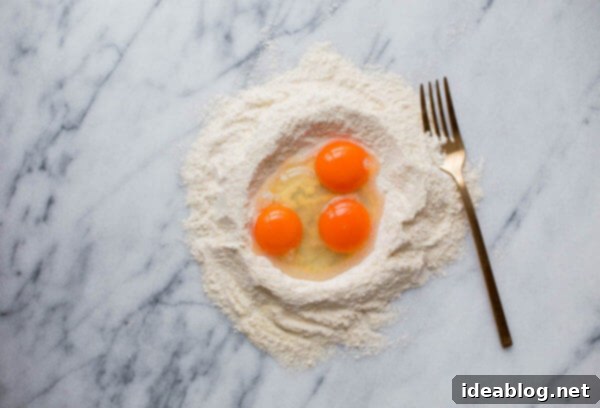
Begin by whisking together the all-purpose flour, semolina, and salt in a small bowl. This ensures even distribution of the dry ingredients. Next, create a traditional pasta “well” by dumping the flour mixture onto a clean, spacious countertop. Form a large, deep well in the center with your hands, making sure the walls are tall enough to contain the wet ingredients. This classic method is surprisingly straightforward and saves you from dirtying a mixing machine at this initial stage.
Carefully crack the eggs into the center of the well. If you’re making the vibrant pink beet pasta, add the beet puree at this stage as well. Using a fork, gently begin to whisk the eggs, gradually incorporating small amounts of the surrounding dry ingredients into the liquid. Work slowly, drawing flour from the inner walls of the well into the egg mixture. As you continue, the dough will start to thicken, becoming shaggy and somewhat wet.
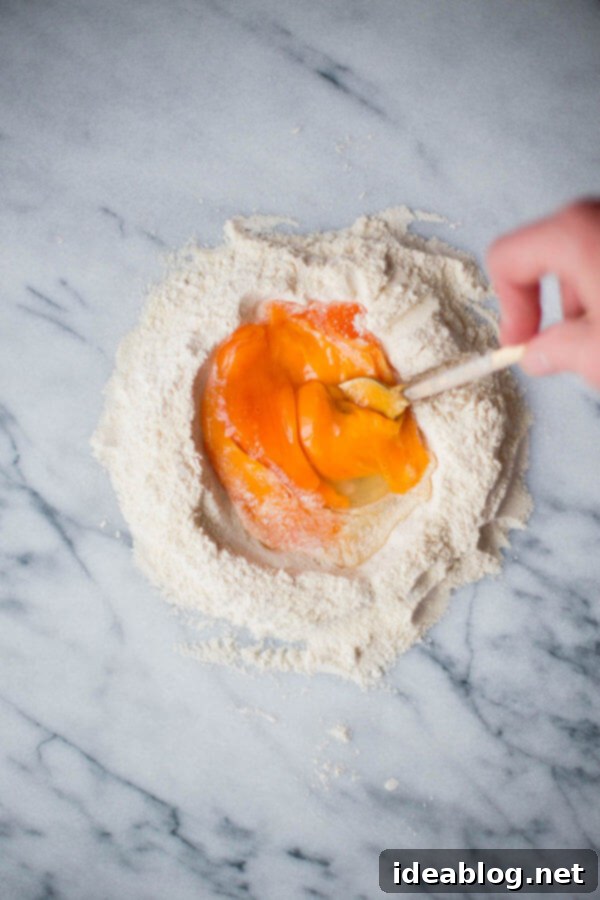
Once the egg mixture is no longer runny and most of the flour has been incorporated, set the fork aside. Now it’s time to get your hands dirty! Use floured hands (and a bench scraper, if you have one, to help gather stray bits) to bring the shaggy dough together. At this point, it will still be fairly sticky and somewhat crumbly, but don’t worry – it’s all part of the process.
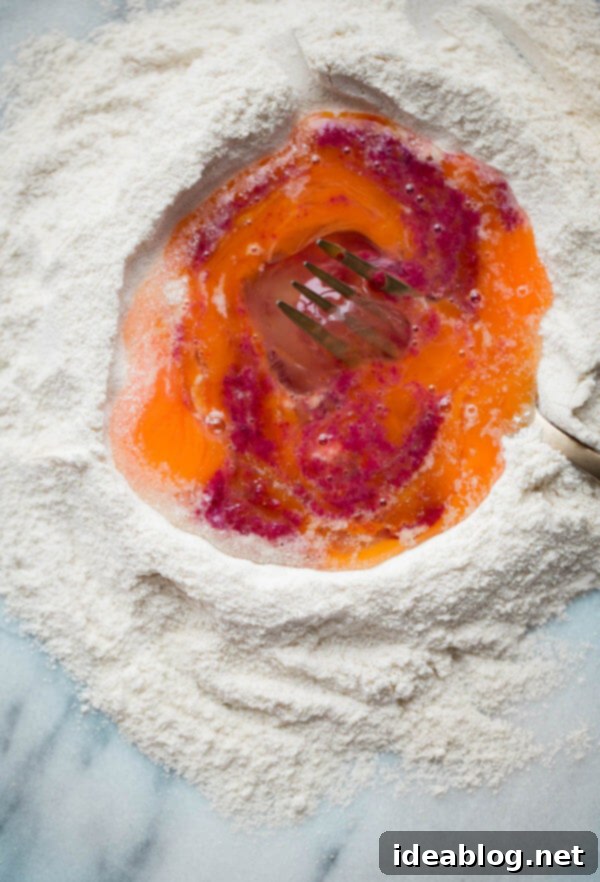
Now comes the kneading – a vital step for developing the gluten and creating a smooth, elastic pasta dough. This will be a firm and dense dough, so prepare for a good arm workout! Knead the dough vigorously for a full 10 minutes. Set a timer to ensure you don’t cut this crucial step short. If the dough starts to stick to your countertop, dust it lightly with a little extra all-purpose flour. The ideal consistency is slightly tacky, but definitely not sticky. As you continue to knead, you’ll feel the dough transform, becoming noticeably smoother, more pliable, and wonderfully elastic.
Once your kneading workout is complete and the dough is perfectly smooth and springy, divide it into two equal portions. Gently pat each portion into a thick disc shape. Wrap each disc tightly in plastic wrap to prevent it from drying out, and allow it to rest at room temperature for at least 30 minutes, or up to an hour. This resting period is critical: it allows the gluten to relax, which makes the dough much easier to roll and shape without tearing. It also gives the dry ingredients ample time to fully hydrate. Do not be tempted to skip this essential step!
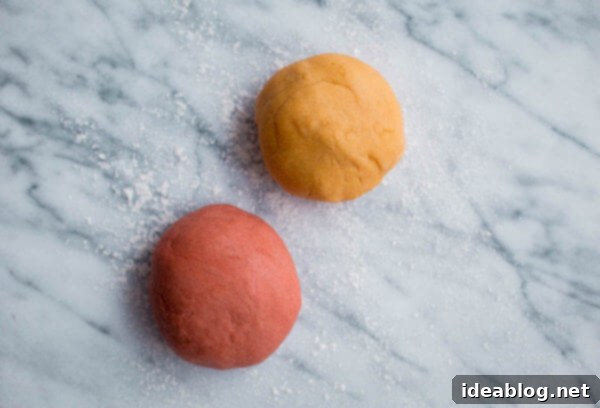
After the dough has rested, it’s time for the fun part: rolling! Set up your pasta machine according to the manufacturer’s instructions. Put on some upbeat music and immerse yourself in the rhythmic process. You’ll be amazed at your developing skills as the dough transforms into long, silken sheets. Homemade pappardelle is just around the corner!
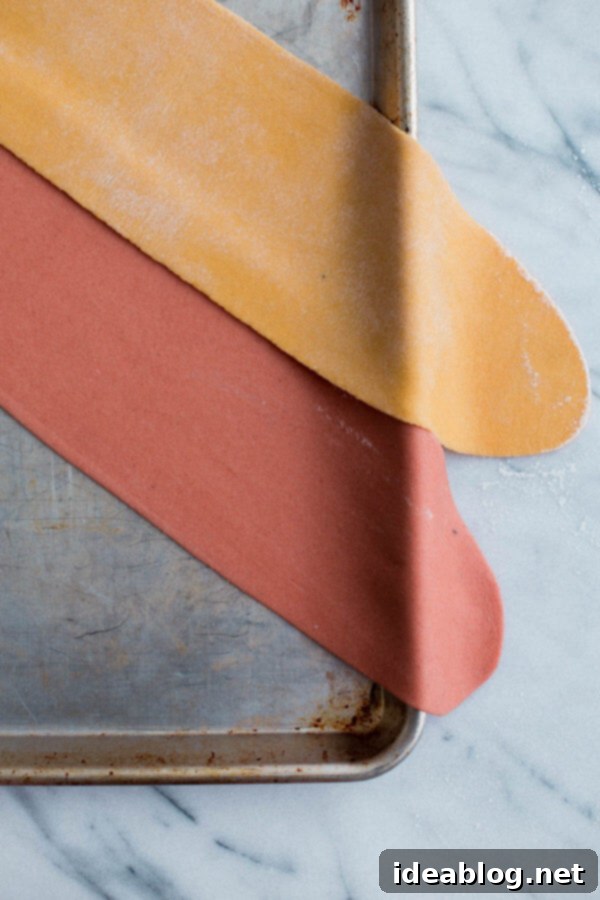
Working with one portion of dough at a time, begin by passing it through the widest setting of your pasta machine. Fold the dough in half or in thirds (like an envelope), dust lightly with flour if needed, and pass it through again. Repeat this folding and rolling process four to five times at the widest setting. This helps to further knead the dough and ensure a smooth, even sheet. Then, gradually reduce the thickness setting on your machine, one notch at a time, feeding the dough through each setting until you reach setting ‘4’. For pappardelle, I personally prefer a slightly thicker noodle that offers a satisfying chew, but you can adjust this to your own preference. If your pasta sheet becomes too long to handle, simply cut it in half before continuing to roll.
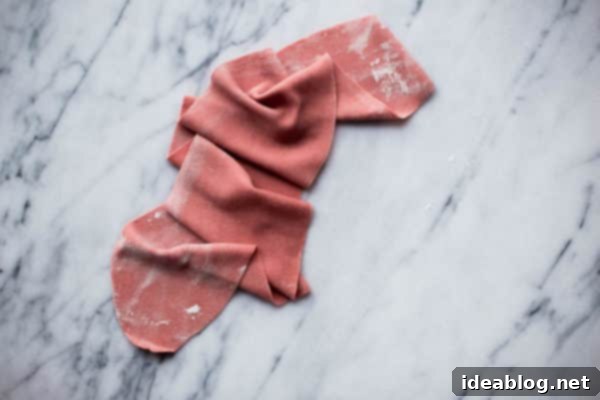
For those making the beet pasta, you’ll notice a beautiful, subtle pink develop. If you desire an even deeper, more vibrant hot pink color, simply incorporate a bit more beet puree than specified in the recipe. The beet flavor itself is remarkably neutral and will not be detectable in the final cooked pasta. I opted for a softer, muted pink, and I particularly love the aesthetic appeal of pairing both the traditional golden yellow and the delicate pink pappardelle pasta together in a single serving bowl – it makes for a visually stunning dish!
Of course, you can always skip the beet puree entirely and simply double the traditional pasta recipe to make a larger batch of classic egg noodles. Once your pasta dough sheets are rolled to your desired thickness, it’s time to cut them into the characteristic wide pappardelle ribbons. Lightly dust the top of the pasta sheet with flour and fold the long strip in half, then fold it in half once more, as if creating an envelope. Using a sharp chef’s knife, carefully cut the folded pasta lengthwise into approximately 1/2-inch wide strips. Don’t worry if they aren’t perfectly uniform; the rustic charm of homemade pasta is part of its appeal. Gently unfold the cut noodles, dust them lightly with semolina flour to prevent sticking, and arrange them in loose nests on a parchment-lined baking sheet until you are ready to cook.
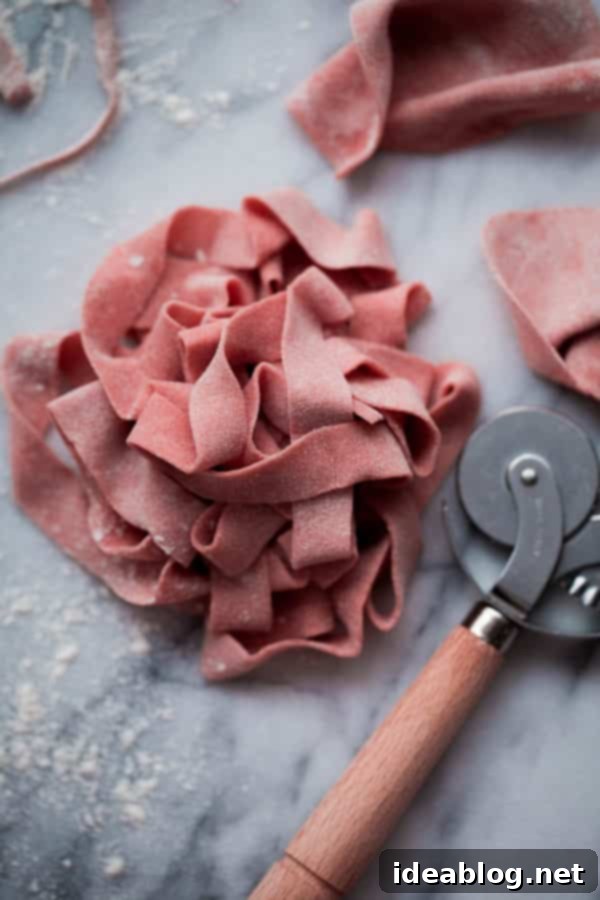
Once all your fresh pappardelle pasta is prepared and waiting, bring a generously sized pot of well-salted water to a rolling boil. It’s crucial to use a large pot to ensure the pasta noodles have ample space to spread out and cook evenly. Remember that fresh pasta expands as it cooks, so a cramped pot can lead to sticky, unevenly cooked results. The salt in the water is also essential, seasoning the pasta from within and enhancing its overall flavor.
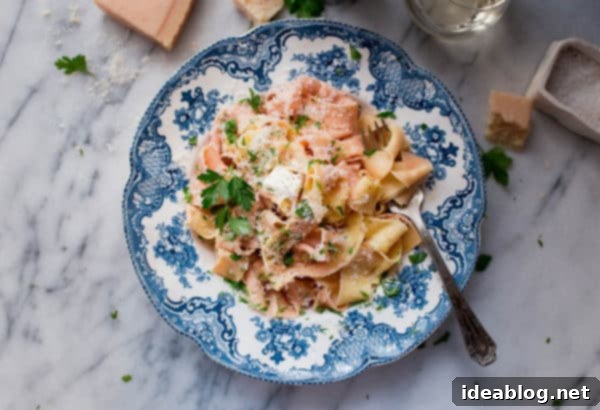
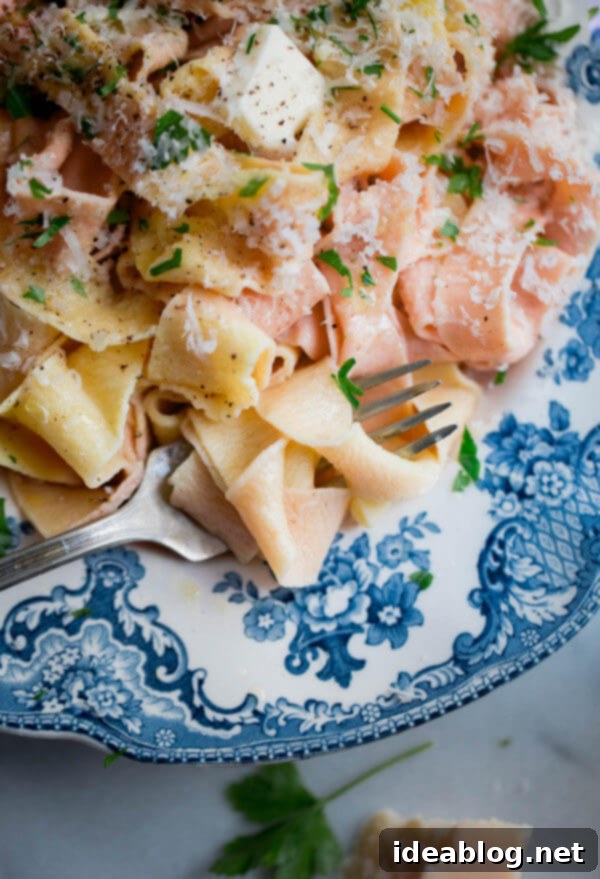
As your pasta cooks, take a moment to prepare your desired sauce. This homemade pappardelle pairs beautifully with a wide array of options, from a simple butter and sage sauce to a rich Bolognese. The creamy leek and pancetta sauce mentioned earlier would be an absolutely fantastic choice for these wide noodles! For a quick and comforting meal, you can simply toss the freshly cooked pasta with a generous knob of butter, plenty of freshly ground black pepper, a splash of the starchy pasta cooking water to create a silky emulsion, and a liberal dusting of finely grated Parmigiano-Reggiano cheese. Serve immediately and savor every bite.
Heaven in a bowl!
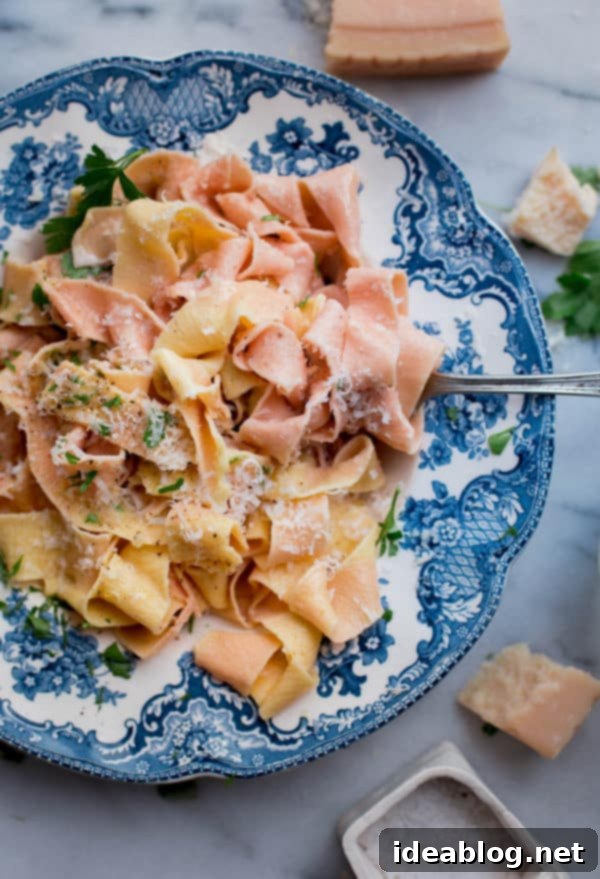
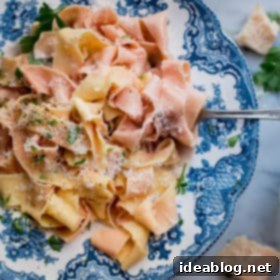
Homemade Pappardelle Pasta Recipe
Pin
Review
SaveSaved!
Equipment
-
KitchenAid 5 Qt. Artisan Stand Mixer (Optional, for ease)
-
KitchenAid 3-Piece Pasta Attachment Set (Recommended with stand mixer)
-
Marcato Pasta Machine (Manual or electric)
-
Rolling Pin (Alternative to pasta machine)
-
Bench Scraper (Helpful for dough handling)
Ingredients
Traditional Pappardelle Pasta:
- ½ cup (70 g) unbleached all-purpose flour plus more for kneading and dusting
- scant ½ cup (85 g) semolina flour
- ½ teaspoon kosher salt
- 1 large egg, plus 2 large egg yolks
Beet Pappardelle Pasta:
- ¾ cup (100 g) unbleached all-purpose flour plus more for kneading and dusting
- scant ½ cup (85 g) semolina flour
- ½ teaspoon kosher salt
- 1 large egg, plus 2 large egg yolks
- 2 tablespoons beet puree see notes for directions on making homemade beet puree
Instructions
-
If you are preparing both the traditional and beet pasta doughs (for a stunning dual-color effect), prepare each dough separately, one at a time, following the instructions below. If you prefer to make a full pound of just one type of dough, simply double the recipe quantities for that specific dough and proceed as follows – however, make sure to portion the kneaded dough into four pieces for rolling, instead of just two.
-
Prepare the pasta dough: In a small bowl, thoroughly whisk together the all-purpose flour, semolina, and salt. Transfer the dry ingredients to a clean countertop, forming them into a neat mound. Create a large, deep well in the center of the mound with your hands, ensuring the sides are sturdy enough to contain the wet ingredients without spillage.
-
Crack the eggs into the well (and add the beet puree if you are making the vibrant beet pappardelle). Using a fork, gently whisk the eggs together in the center. Continue to whisk, slowly drawing in small amounts of the flour mixture from the sides of the well into the egg mixture. Keep working until the dough starts to come together in a shaggy mass, and the egg mixture is no longer runny.
-
Once the dough is mostly combined, set the fork aside. Using floured hands (or a bench scraper to help gather), continue to incorporate any remaining dry ingredients until the dough forms a cohesive mass. Begin to knead the dough. This is an important step! Knead vigorously for a full 10 minutes until the dough is smooth, supple, and very elastic. Dust your countertop and hands lightly with all-purpose flour as necessary to prevent sticking; the dough should be slightly tacky but not sticky. After kneading, divide the dough in half, flatten each portion into a thick disk with your palm, and wrap tightly in plastic wrap. Allow the dough to rest at room temperature for 30 minutes to 1 hour; this allows the gluten to relax, making it much easier to roll.
-
Roll the Pasta Dough: Prepare a sheet pan by lining it with parchment paper or dusting it lightly with semolina flour; set aside. Working with one portion of dough at a time, unwrap it and lightly dust it with flour (the dough will absorb some flour during resting and may feel a bit tacky). Flatten the dough into an oval shape, no more than ½-inch thick. Feed the dough gently through an electric or manual pasta machine at its widest setting. Repeat this four more times, folding the dough in half each time before re-feeding, and dusting lightly with flour if it sticks. This process further kneads and smooths the dough.
-
Continue to roll the pasta dough through the machine, gradually narrowing the opening by adjusting the knob one turn at a time, until you reach setting “4” on your pasta machine (or to your desired thickness for pappardelle, which is generally a bit thicker). If the sheet becomes too long to manage, cut it in half. At this point, you can trim any scraggly ends or sides for a neater appearance. Lay the rolled pasta sheets on the prepared baking sheet and let them air dry for about 5 minutes before cutting. Lightly dust the top of the pasta sheet with flour and fold it in half lengthwise. Dust lightly again and fold in half once more, creating a compact stack. Using a large, sharp chef’s knife, cut the folded pasta lengthwise into approximately ½-inch wide ribbons. Don’t worry if they are not perfectly uniform; homemade pasta has rustic charm. Gently unfold the cut noodles, dust them with semolina to prevent sticking, and arrange them in several small, loose nests on the parchment-lined sheet pan until ready to cook. Repeat this entire process with the remaining portions of pasta dough.
-
Cook the Pasta: Bring a large pot of generously salted water to a rolling boil. Carefully add the homemade pappardelle pasta, stirring gently to prevent the noodles from sticking together. Cook the pasta, stirring occasionally, until it reaches an al-dente texture. Fresh pasta cooks very quickly; depending on its thickness, it should only take about 2 to 3 minutes at most. Once cooked, promptly drain the pasta and serve immediately with your favorite sauce.
Recipe Yield Notes:
- Each individual pasta dough recipe provided above (classic or beet) yields approximately 1/2 lb of fresh pasta. If your goal is to make 1 lb of fresh pasta in a single color, simply double the quantities for that particular dough recipe. When doubling, follow the same instructions, but remember to divide the kneaded dough into four portions for rolling, rather than just two, to manage the larger quantity more easily.
Tips for Success:
- To create your own homemade beet puree: procure one (15-ounce) can of cooked beets packed in water. Drain the beets thoroughly in a fine-meshed sieve. Transfer the drained beets to a small food processor and blend until an exceptionally smooth puree is achieved. You may need to pause and scrape down the sides of the bowl with a spatula a few times to ensure uniformity.
- Any unused beet puree can be stored in an airtight container in the refrigerator for up to 3 to 4 days. It’s a versatile ingredient; I often incorporate leftover beet puree into smoothies for a nutritional boost, and it can also be used to add natural color and moisture to cakes and other baked goods.
